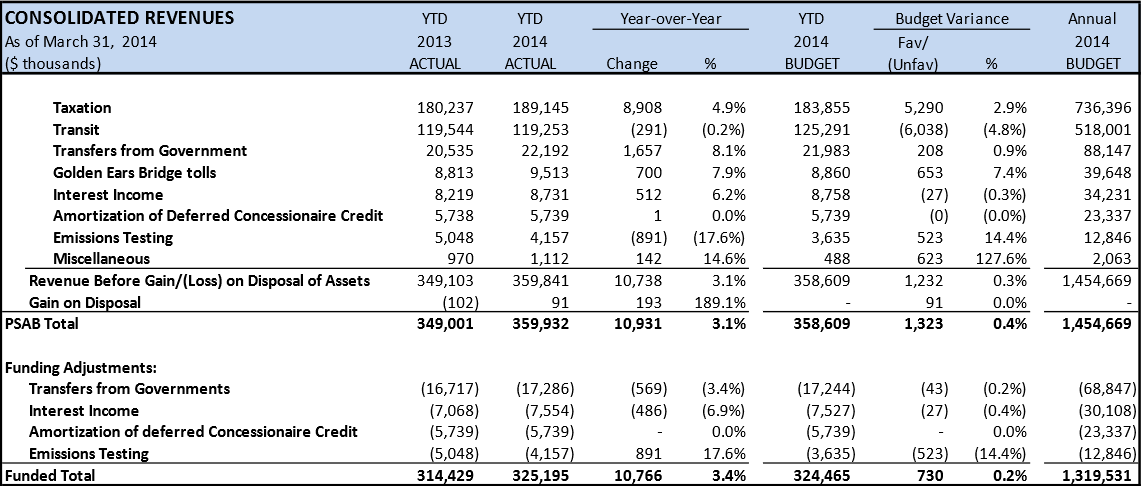With all the excitement around SkyTrain over the last few weeks, you might have missed that TransLink released their first quarter results on Friday, July 25th.
On a good note, TransLink had a $15.9 million surplus in the first quarter. TransLink had budgeted for a slight deficit in the first quarter. According to TransLink, the surplus was mainly due to when it will contribute money to municipal governments in Metro Vancouver to support the Major Road Network.
 |
| TransLink revenue, compares Q1 2014 to Q1 2013. Select table to enlarge. |
The majority of TransLink revenue comes from taxation. TransLink budgeted for an increase in the revenue it receives from fuel tax and parking tax, and a reduction in revenue it receives from property tax (due the Mayors’ Council decision to remove a time-limited property tax to pay for transit expansion.)
TransLink received $4.9 million more then it budgeted from fuel tax. According to TransLink “the increase is largely attributable to higher commercial diesel sales.” TransLink also noted that the lower value of the Canadian dollar is likely reducing the amount of cross-border fuel purchasing.
TransLink also received $467,000 more than budgeted from the parking tax. This tax is applied when paying for parking in a private lots. Apparently the increase was likely due to some parking vendors pocketing extra cash by not lower their “all inclusive” parking rate when the province switched from HST back to PST.
The second largest source of revenue for TransLink is from fares. Fare revenue in the first quarter of 2014 was short by $6 million. TransLink attributes this to the 2.9% decrease in ridership in the first quarter of 2014 compared to the same period in 2013.
 |
| TransLink expenses by segment, compares Q1 2014 to Q1 2013. Select table to enlarge. |
As part of its quarterly report, TransLink also makes available various non-financial performance indicators.
In the first quarter of 2014, TransLink bus service hours slightly increased, but the amount of kilometres buses travel decreased. In the first quarter of 2013, there were 58.8 million boardings. In the first quarter of 2014, there were 55.8 million boardings, a reduction of about 5%.
Rail transit services hours and kilometres travel decreased in the first quarter of 2014, compared to the first quarter of 2013. There was 28.8 million boardings on SkyTrain and West Coast Express in the first quarter of 2013, and 28.3 million boarding on rail transit in the first quarter of 2014. This is a reduction of about 1%.
Service optimization likely played a role in reduced transit ridership in places like Coquitlam, but I have wonder if overcrowding in Vancouver is discouraging people from taking transit.
As I posted about previous, while transit ridership continues to grow in the South of Fraser, ridership is shrinking in the City of Vancouver where the largest share of bus ridership resides. Besides overcrowding, could Vancouver’s investment in walking and cycling infrastructure be encouraging less people to take transit?
On a different note, TransLink currently has $1.1 billion in active capital improvement projects on the go.
Major project construction that will be starting shortly include:
-Metrotown SkyTrain Station and Bus Exchange Upgrade: $35 million
-Commercial-Broadway SkyTrain Station Expansion: $32 million
-New Westminster SkyTrain Station Upgrade: $9 million.
For more information on TransLink financial and performance data, check out the full first quarter 2014 report.

No comments:
Post a Comment